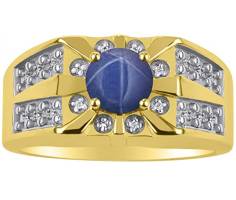Whispers of Light: Understanding Asterism and Chatoyancy in Star Gemstones
Asterism in gemstones, often seen in sapphires, is a captivating display where light interacts with needle-like inclusions, creating a mesmerizing dance of star rays on the gem’s surface.
Quick Summary:
Phenomenal Gemstones: Asterism and Chatoyancy |
- Asterism: This phenomenon creates a star-like pattern on gemstones, predominantly in corundum (sapphires and rubies) and some quartz. It’s caused by light reflecting off needle-like inclusions, typically Rutile.
- Chatoyancy: Also known as the cat’s eye effect, produces a luminous band across the gemstone, reminiscent of a cat’s eye, and is mainly due to parallel inclusions like Rutile or hematite.
Types of Gemstones Exhibiting These Phenomena: |
- Star Gemstones: Common in sapphires and rubies, where rutile inclusions create a six-rayed star. Rarer twelve-rayed stars can occur with specific inclusions.
- Cat’s Eye Gemstones: Chrysoberyl is famous for its sharp cat’s eye effect. Tiger’s eye quartz and moonstone also display Chatoyancy.
- Other Varieties: Aquamarine, emerald, malachite, rose quartz, black diopside, garnet, spinel, and moonstone can show either asterism or Chatoyancy.
Formation and Characteristics: |
- Rutile Needles are the Primary architects of these phenomena. Their alignment within the gemstone influences the star’s appearance or the cat’s eye effect.
- Epiasterism and Diasterism are Two forms of asterism. Epiasterism involves light reflecting from inclusions within the gemstone, while diasterism requires backlighting for the star to be visible.
Role of Light Source: |
- A single, direct light source enhances the visibility of asterism and Chatoyancy. Diffused light can diminish the clarity of these effects.
Gem Cutting and Value: |
- The gem’s cut (often cabochon) highlights these effects. The clarity and intensity of the phenomenon, the stone’s color, and the cut’s quality influence these gemstones’ value.
Cultural and Mythological Significance: |
- These gemstones have been historically linked to various superstitions, beliefs in magical powers, and cultural symbolism, often seen as symbols of guidance, fortune, and spiritual harmony.
Scientific and Gemological Importance: |
- Studying these phenomena in gemstones offers insights into geological processes and the mineral’s origin. They are significant for their aesthetic appeal and scientific value in understanding the Earth’s mineralogy.
- Optical Phenomena: Asterism vs Chatoyancy:
- The Influence of Light on Revealing Asterism and Chatoyancy:
- Sapphires, Rubies, and the Wonders of Asterism.
- Star Rubies, A Symmetry of Light and Reflection:
- The Intriguing Case of Black Star Sapphires.
- Needle-Like Inclusions and the Brilliance of Star Gemstones
- Rutile: Titanium Dioxide as an Inclusion.
- How does Inclusion Alignment Influence the Number of Rays in the Star?
- Other Gemstones That Display Asterism and Chatoyancy.
- On Garnet, Spinel, and Moonstone: More Star Gemstones.
- Apparent Asterism in Chrysoberyl.
- Understanding Star Stones: The Gemologist Perspective.
Celestial Patterns in Earth’s Treasures:
Other gem varieties apart from sapphire also exhibit these star patterns, each presenting its unique version of this natural spectacle. The opalescent display is most prominent under direct light, revealing a star-like shape that gracefully glides over the gemstone’s surface. This captivating feature transforms the gem into a living canvas, showcasing the profound beauty hidden within the Earth’s creations.
Each star gemstone, with its asterism, is like a celestial body in the vast universe of gemology, inviting admirers to ponder the wonders of the natural world. This phenomenon turns an ordinary stone into a storytelling artifact, enchanting viewers with its interplay of light and shadow and leaving a lasting impression of nature’s artistic prowess.
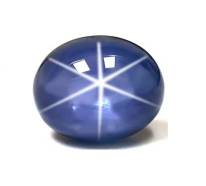
Untreated 38.04 Carat Natural Star Sapphire Oval |
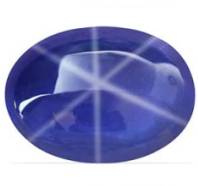
Untreated 19.01 Carat Natural Star Sapphire Oval |
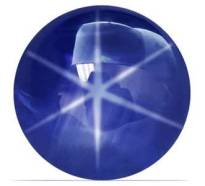
Untreated 14.96 Carat Natural Star Sapphire Round |
Chatoyancy: The Cat’s Eye Effect:
In the mystical depths of the Earth, where nature crafts its masterpieces, there exists a wondrous phenomenon known as Chatoyancy or the cat’s eye effect. This magical trait transforms ordinary gemstones into mesmerizing orbs of light and shadow, akin to the enigmatic gaze of a feline. The tale begins deep within the gem, where fine, needle-like inclusions, usually of Rutile or hematite, lie in silent wait. These slender inclusions, aligned like disciplined soldiers, set the stage for an extraordinary light show.
Light Is The Playright of This Celestial Dance:
As light touches the surface of a cabochon-cut gem, it whispers to these hidden inclusions, coaxing them to play with its rays. The result is a narrow band of light that glides across the stone’s surface, much like the narrowing pupils of a cat in bright light.
Captivating Cat’s Eyes: Unveiling the Mystique of Chrysoberyl and Tiger’s Eye Quartz:
Chrysoberyl, the guardian of the most distinct cat’s eye effect, proudly bears this phenomenon in its yellowish variety. Its inclusions form an effect known as ‘silk,’ crafting a sharp and definitive line of light that is the envy of other gemstones. In the tiger’s eye quartz, the cat’s eye leaps into a golden-brown world with the interplay of quartz and crocidolite fibers.
Mystical Glow: Exploring the Enchanting Chatoyancy of Moonstone:
Moonstone, a gem of the feldspar family, wears Chatoyancy like a cloak of mystery. It is a tale of iridescent light, with colors ranging from the mystical blues to the deep grays of twilight. The inclusions within the moonstone catch the light, casting a glow that dances with the shadows.
Corundum Chronicles: The Mystical Dance of Sapphires and Rubies:
In the world of corundum, sapphires and rubies join this enchanted dance, displaying Chatoyancy and asterism. These gemstones, steeped in legend and lore, show the cat’s eye effect through a veil of red and blue, embodying the elegance and mystique of their creation.
Nature’s Palette: Aquamarine and Emerald’s Alluring Cat’s Eye Display:
Aquamarine and Emerald from the Beryl family occasionally step into the limelight, showcasing their versions of the cat’s eye effect. These gems, reminiscent of the ocean depths and the lushness of the forest, add a splash of color to this fascinating phenomenon.
Echoes of the Forest: Unveiling Malachite’s Unique Chatoyancy:
In the heart of this narrative, malachite emerges with its unique Chatoyancy. This copper carbonate mineral’s deep, verdant hues are intertwined with fibrous inclusions, creating a play of light that echoes the whispers of ancient forests.
The story of Chatoyancy is one of nature’s artistry, a phenomenon where light and minerals unite to create a spectacle of beauty and mystery. Each gemstone with its cat’s eye effect is a character in this tale, adding its unique voice to the chorus of nature’s wonders. Chatoyancy is not just a feature in gemology but a chapter in the grand story of the Earth’s treasures.
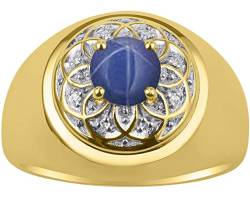
14K Yellow Gold Designer Gypsy Blue Star Sapphire & Genuine Sparkling Diamond Mens Ring |
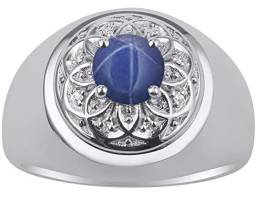
14K White Gold Designer Gypsy Blue Star Sapphire & Genuine Sparkling Diamond Mens Ring |
Optical Phenomena: Asterism vs Chatoyancy:
The Mystique of Star Gemstones: Unveiling the Celestial Dance and the Feline Gaze:
Different mineral components crystallize and harden at different temperatures deep inside the earth. It is an inherent property of matter that disparate materials melt and crystallize at different temperatures.
The staggered crystallization causes the motley of constituents to separate into layers. Titanium oxide, in particular, is squished out of the crystal structure and takes the form of tiny needles crowded together in a specific pattern. This plethora of fine needles is a typical inclusion seen in corundum. It is called rutile.
Titanium oxide (or rutile) needles are excellent reflectors of light. And occasionally, they are present in sufficiently large numbers in a crystal. A skilled cutter can recognize the opportunity this presents. He cuts the stone at carefully calculated angles into an unfaceted cabochon and gives it a high polish. The gem now behaves like a convex lens for incident light.
The concentration of light rays by the lens-like gem and the intense reflection from the rutile needles orchestrate light to conjure up the star onto the face of the stone. We see here that the inclusions add a lot of value to the gemstone.
Chatoyancy, on the other hand, presents a luminous band or eye, akin to the piercing gaze of a cat, caused by light reflecting off parallel inclusions. These phenomena bring a touch of cosmic wonder and natural mystique to the gemstones they adorn.
Rutile Needles: Architects of the Starry Effect:
In the realm of asterism, the needle-like inclusions, primarily composed of Rutile, are the architects of the star effect. With its high refractive index, Rutile scatters light to form the starry silhouette that dances across the gemstone’s surface. When aligned perfectly, these rutile needles orchestrate a symphony of light, resulting in the much-adored six-rayed star. However, rutile and hematite inclusions can also yield a rarer twelve-rayed star, a sight of extraordinary beauty.
The Enchantment of Chatoyancy:
Chatoyancy, often likened to the eyes of a cat, relies on inclusions similar to asterism. However, it manifests as a singular, luminous band rather than a star. Chatoyancy occurs when light is reflected off parallel inclusions within the gem, creating a captivating eye-like effect that enhances the gemstone’s allure and mystery.
The Rarity and Value of Star Gemstones:
The allure of star gemstones lies not just in their beauty but also in their rarity. The precise alignment of inclusions necessary for asterism is a rarity, making these gemstones highly sought after. The clarity and intensity of the phenomenon, the stone’s color, and the cut’s quality influence these gemstones’ value.
Epiasterism and Diasterism: The Dual Facets of Asterism
There are two distinct types of asterism – epiasterism and diasterism. Epiasterism, common in sapphires, results from light reflecting off parallel inclusions within the gemstone. Diasterism, on the other hand, is observed in gems like Rose Quartz and Almandine Garnet, where light must pass through the stone, requiring backlighting to reveal the star.
Asterism in Culture and Mythology
Beyond their physical allure, star gemstones are steeped in rich cultural and mythological significance. In Indian mythology, for instance, star sapphires were linked to Saturn and believed to bring protection and good fortune. The ancients associated asterism with protective energies, guidance, intuition, and celestial connections in metaphysical beliefs. They thought these gemstones to be more than mere ornaments; they were conduits of cosmic energy and harbingers of good luck.
14K Yellow Gold Oval Blue Star Sapphire & Genuine Sparkling Diamond Mens Ring
The Influence of Light on Revealing Asterism and Chatoyancy:
In the Realm of Reflected Light: The Heart of Asterism:
Asterism is akin to a celestial event captured in stone in the mystical world of gemstones. This optical effect, creating stars within a gem, is born from the interplay of light and the dense inclusions of tiny fibers hidden in its heart. Picture a beam of light wandering into the depths of a gemstone, only to be greeted and transformed by these minute, aligned inclusions. This transformation is where the journey to asterism begins.
The Artisans Within Rutile Needles and Hematite:
The primary architects of this starry phenomenon are often rutile needles, slender and precise. Light encountering these parallel inclusions reflects in a manner that makes a star seem to emerge on the stone’s surface. In some instances, where hematite inclusions accompany Rutile, the star can display even more rays, turning a simple celestial body into a more complex constellation.
Chatoyancy: When Light Meets the Cat’s Eye:
Chatoyancy, or the cat’s eye effect, unfolds its narrative differently but equally fascinatingly. Here, the gemstone acts as a canvas for an optical effect that creates a single, silky band of light, moving just like the narrowed eye of a cat. This phenomenon occurs when parallel needle-like inclusions cause light to reflect in a linear pattern.
Epiasterism and Diasterism. The Twin Chapters of Starlight:
Asterism in gemstones narrates its story in two distinct styles – epiasterism and diasterism. Epiasterism, often seen in gemstones like sapphires, emerges when the star is formed by light reflected from inclusions within the gemstone. Diasterism, a less common but equally enchanting phenomenon, occurs when the stone is illuminated from behind, allowing light to travel through it and reveal a star.
Illuminating the Depths: The Role of Light and Angle
At the core of these phenomena is the way light interacts with the gemstone’s internal world. Specific light reflection or refraction angles project the stars on the gems’ surface. Each movement of the stone or change in light source can alter the star’s appearance, making it a dynamic and ever-changing spectacle.
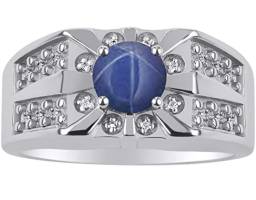
14K White Gold Designer Starburst Blue Star Sapphire & Genuine Sparkling Diamond Ring For Men |
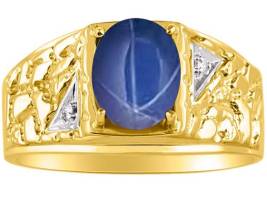
14K Yellow Gold Designer Nugget Ring Blue Star Sapphire & Genuine Sparkling Diamonds Mens Ring |
The Role of Light Source in Displaying Asterism and Chatoyancy:
In understanding asterism and Chatoyancy in gemstones, the role of the light source is fundamental. These phenomena depend heavily on how light interacts with the internal features of the gemstone.
The Interaction with Light:
Asterism occurs when light enters a gemstone containing aligned inclusions, like rutile needles. This interaction with light causes the reflection and refraction of light, which in turn creates the star-shining effect on the stone’s surface. The light’s angle and intensity largely determine the visibility and clarity of this star pattern.
The Single Light Source
A single, direct light source is crucial for both asterism and Chatoyancy. This singular light displays the star or cat’s eye effect most vividly. Under a single light source, the star or cat’s eye moves with the light, demonstrating the dynamic relationship between the gemstone and its internal structure with the external light.
Diffused Light and Its Effects
In contrast, when exposed to diffused light sources, such as fluorescent lights, the clarity of these phenomena can diminish. Multiple light sources can disrupt the sharpness of the star or cat’s eye effect, making it less discernible.
Conclusion: Light as a Revealer
In summary, the role of the light source is crucial in revealing the beauty of asterism and Chatoyancy in gemstones. The quality, direction, and type of light determine how these unique features are displayed and perceived, highlighting the intricate relationship between light and the internal characteristics of gemstones.
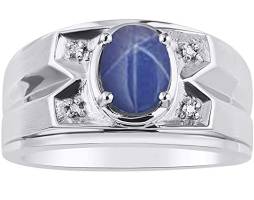
14K White Gold Rings Classic Designer Style Blue Star Sapphire & Genuine Sparkling Diamond Mens Ring |
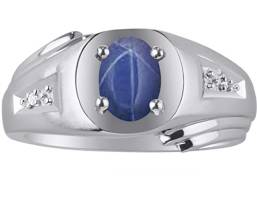
Mens Rings in 14K White Gold Classic Designer Style 8X6MM Blue Star Sapphire & Genuine Sparkling Diamond |
Sapphires, Rubies, and the Wonders of Asterism.
The Star Sapphire: The Asteria of the Gem World:
The star sapphire, a variety of the mineral corundum, is renowned for its captivating asterism – a star-shaped light display. This phenomenon, originating from Ancient Greek ἀστήρ (astḗr), meaning ‘star,’ is a result of light reflecting or refracting within the gemstone. When cut en cabochon (shaped and polished rather than faceted), these gemstones reveal their stunning secret: a luminous star-like pattern.
The Scientific Symphony Behind the Star:
Asterism in star sapphires, the archetype of asteria, is produced through a symphony of natural elements. Rutile, a common inclusion in these gems, plays a pivotal role. These needle-like rutile inclusions, arranged in parallel patterns, interact with light, causing the star effect. Titanium dioxide impurities in sapphires also contribute to this, enhancing the star’s visibility.
Color and Clarity in Star Sapphires:
Interestingly, the presence of Rutile creates the star effect and influences the gem’s color and clarity. The trade-off between the star’s distinctness and the gem’s color saturation is delicate. Cutters must skillfully select material that showcases a vivid color and a clear, sharp star. Natural star sapphires often display their celestial pattern best under direct sunlight or intense indoor light, with the star’s clarity and movement varying with the angle of light.
Star Rubies, A Symmetry of Light and Reflection:
The Allure of Star Rubies:
At the heart of every star ruby lies a tale of mesmerizing symmetry and an interplay of light and shadow. More coveted and rarer than their star sapphire counterparts, these gems capture the essence of asterism with a dance of light that seems almost ethereal. The most prized star rubies originate from Myanmar, where the unique formation of silk within these gems gives rise to their distinct appearance.
Understanding Asterism in Star Rubies:
Asterism, derived from the Greek word for ‘star,’ is a phenomenon where a star-shaped light pattern appears on the surface of gemstones, notably in star rubies. This effect is caused by needle-shaped rutile inclusions, colloquially called “silk,” which refract and reflect light, creating a captivating star pattern. Each star ruby possesses a unique star, a signature shaped by its growth characteristics.
Nature symmetrically arranges these rutile inclusions in star rubies, allowing light to reflect in multiple directions. The result is a star that becomes more pronounced under direct light, an optical spectacle that has been the subject of legend and lore.
The Gem-Cutting Craft: Bringing Stars to Life:
Typically, cutters shape these rubies en cabochon with high domes, a style that accentuates the star effect. Cutting and shaping star rubies is a delicate balance, aiming to properly align the rutile needles to display the asterism. The perfect centering of the star is a testament to the skill of the gem cutter.
Clarity and Color: The Heart of a Star Ruby:
The clarity of a star ruby is integral to its beauty. Unlike other gemstones where inclusions are often undesirable, rutile needles in star rubies are essential for the star effect. These inclusions give the gem a silky luster, with the best specimens achieving a balance between translucency and the prominence of the star.
In terms of color, star rubies span a spectrum from deep crimson to vibrant pink. Even a hint of red qualifies a gem as a star ruby, with variations in color influencing its appearance and value.
The Intriguing Case of Black Star Sapphires.
Formation and Essence:
Black Star Sapphires, distinguished for their enigmatic beauty, owe their asterism to hematite-ilmenite needles. These needles, intersecting typically at 120 degrees, are the architects of the gem’s star effect. Unlike the more commonly known rutile silk that creates stars in other sapphire varieties, these particular inclusions are responsible for the unique golden hue of the star seen in Black Star Sapphires.
The Golden Star Effect:
The star effect in Black Star Sapphires is a convergence of light and minerals. The hematite-ilmenite needles within the stone form a lattice-like structure. When light falls on these inclusions, it scatters to form a star with rays that exhibit a striking golden color. This contrast against the black backdrop of the sapphire creates a mesmerizing visual effect, making these gems highly prized.
Needle-Like Inclusions and the Brilliance of Star Gemstones
The Magic of Dense Inclusions and Tiny Fibers.
Unveiling the Microscopic Marvels:
Star gemstones, celebrated for their mesmerizing asterism, owe their allure to minuscule yet mighty elements within their crystal lattice. The magic begins with dense inclusions, primarily of Rutile, a titanium dioxide mineral. These inclusions, often needle-like and acicular, are not mere imperfections. Instead, they’re the architects of the star-like patterns that have captured human imagination for centuries.
Rutile: The Artisan of Light:
Tightly packed and aligned in specific geometrical patterns, Rutile needles create the conditions for asterism to emerge. When light strikes these inclusions, it reflects and refracts so that a star-like pattern appears on the gemstone’s surface. Star sapphires and rubies, containing rutile inclusions, most vividly display the phenomenon.
The Optical Ballet of Star and Stone:
The enchantment of a star gemstone lies in its dynamic interaction with light. The star’s visibility and sharpness are a delicate balance of the density and alignment of the rutile needles. Interestingly, the color of the gemstone itself can influence this interplay. A higher concentration of Rutile can lead to a more prominent star. Still, it may also affect the stone’s overall color clarity, necessitating a careful balancing act during the cutting and polishing processes.
Rutile: Titanium Dioxide as an Inclusion.
The Architect of Asterism:
Rutile, a titanium dioxide mineral, is the maestro behind the phenomenon of asterism in star gemstones. These needle-like inclusions, embedded within the gem’s crystal structure, orchestrate a captivating light show. When light encounters these inclusions, it is reflected in specific patterns, creating the illustrious star effect that has fascinated gem enthusiasts for centuries.
Formation and Characteristics of Rutile Inclusions:
Rutile inclusions form naturally within gemstones due to geological processes involving high temperatures and pressures. These conditions encourage the growth of titanium dioxide crystals within the host mineral. The size, density, and alignment of these rutile needles are crucial in determining the visibility and sharpness of the star effect.
Interplay of Light and Crystal:
The essence of asterism lies in the interaction between light and the rutile inclusions. Cutting the gemstone en cabochon, which enhances the surface area for light interaction, makes the star effect most pronounced. The rutile needles, aligned parallel to each other, reflect and refract light, leading to the emergence of a star pattern.
How does Inclusion Alignment Influence the Number of Rays in the Star?
The Symphony of Light and Crystal Structure:
The creation of a star in gemstones, known as asterism, is a captivating play of light and crystal structure. At the heart of this phenomenon are the inclusions, typically Rutile (titanium dioxide), whose alignment within the gemstone’s body is critical in defining the number and appearance of the star’s rays.
Rutile: The Conductor of the Starry Performance:
Rutile inclusions are like conductors in an orchestra, directing how light dances within the gemstone. The alignment and distribution of these needle-like inclusions are vital to the star’s formation. When the inclusions are evenly spaced and parallel, they reflect light in a symmetrical pattern, forming the star.
The Magic of Geometric Arrangement:
The geometric arrangement of the inclusions directly influences the number of rays in a star gemstone. In star sapphires and star rubies, which commonly exhibit a six-rayed star, the rutile needles are typically arranged in three sets of parallel lines, each set oriented at different angles. This arrangement allows for the intersection of the reflected light at the surface, creating the six-rayed star effect.
Variations in Star Patterns:
The fascinating aspect of asterism is its variability. Different gemstones can exhibit different numbers of rays based on the unique arrangement of inclusions within them. For instance, some star gemstones, like certain topazes, may display a four-rayed or eight-rayed star, depending on how the rutile needles are aligned.
The Art of Gem Cutting: Enhancing the Star Effect:
The gem cutter’s skill in orienting the gemstone during the cutting process is crucial. The cabochon cut, a dome-shaped style, is preferred for star gemstones as it maximizes the surface area for light interaction with the inclusions. The cutter must align the gemstone to appropriately position the inclusions to display the star effect most effectively.
Natural vs. Synthetic: Consistency in Star Formation:
Natural gemstones exhibit unique randomness in the alignment of inclusions, leading to individualized star patterns. In contrast, synthetic or treated gemstones may have more uniform inclusion patterns, resulting in more consistent but less unique stars.
Other Gemstones That Display Asterism and Chatoyancy.
The Star Effect in Rose Quartz and Diopside
The Enchanting Rose Quartz:
Rose Quartz, renowned for its delicate pink hue, uniquely displays a mesmerizing six-ray star when expertly oriented and cut. This effect, known as asterism, emerges most vividly in high-quality specimens, particularly those sourced from Madagascar. The darker the stone, the more pronounced the star. In gemology, this phenomenon is a subset of an asterism called Diasterism, observable when light is transmitted through the stone, requiring illumination from behind. This quality adds a layer of mystical allure to rose quartz, making it a coveted choice for its beauty and intriguing optical properties.
The Enigmatic Black Diopside:
Black Diopside, or Indian black star diopside, stands out with its unique four-pointed star due to its composition of calcium magnesium silicate. This star, a captivating visual, is produced by light reflecting off the stone’s surface. We find them in various locations, including Russia, Canada, and parts of the USA. Black diopside features a deep black hue, enhancing the contrast and visibility of its star. In addition to its beauty, the black diopside’s relatively lower hardness on the Mohs scale makes it a delicate but exquisite choice for jewelry enthusiasts.
A Tale of Two Stars: Epiasterism and Diasterism
Asterism in gemstones manifests in two distinct forms: Epiasterism and Diasterism. Epiasterism, seen in stones like sapphires, results from light reflecting off parallel inclusions within the gemstone. On the other hand, Diasterism, as observed in rose quartz, occurs when light passes through the stone, necessitating backlighting to reveal the star. This dual nature of asterism adds a fascinating dimension to the study and appreciation of these gemstones.
On Garnet, Spinel, and Moonstone: More Star Gemstones.
The Radiance of Star Garnets:
Garnets, often associated with deep red hues, also encompass a variety known as star garnets. These gems can present colors from red with a hint of purple to deep purple with red undertones. The star garnet, particularly those from Idaho, is known for its unique asterism. It typically displays a four-rayed or six-rayed star, which adds to its allure and distinction. The star effect in garnets is rare, making these stones a prized addition to collections and jewelry.
The Luster of Star Spinel:
Spinel, a lesser-known but equally captivating gemstone, can also exhibit asterism. The same rutile silk inclusions found in other star gemstones typically cause the star effect in spinel, aligning in a way that reflects light into a star pattern. The appearance of a star in a spinel adds an extraordinary dimension to an already prized gemstone.
The Ethereal Moonstone:
Moonstone, a gemstone steeped in lore and romance, is another magnificent example of asterism. Unlike the more common adularia moonstone, known for its billowy light effect or adularescence, some moonstones can display a star effect. This asterism, often subtler than that seen in sapphires or garnets, adds to the stone’s mystical and enchanting qualities. The phenomenon in the moonstone is typically the result of light reflecting from internal structures within the stone, creating a serene and captivating star.
Understanding Asterism in Gemstones:
Asterism in gemstones like garnet, spinel, and moonstone is a fascinating interplay of light, mineral inclusions, and the gem’s internal structure. The interplay creates a star pattern resulting from light reflecting off aligned inclusions or structures within the stone. The rarity and precision required for these inclusions to form a clear and distinct star pattern contribute significantly to the value and allure of these gemstones.
Apparent Asterism in Chrysoberyl.
Intricacies of Chatoyancy in Chrysoberyl:
Chatoyancy in gemstones is typically created by light reflecting off parallel needle-like or tubular inclusions within a cabochon-cut stone.
Microscopic Observations. Formation Of A Pair Of Perpendicular Cat’s-eyes:
In chrysoberyl, microscopic examination reveals two distinct sets of inclusions. One set consists of densely packed minute particles aligned in a single direction, producing a thick band of reflected light. This orientation is often diagonal.
The second set of inclusions comprises needles aligned in the same direction as the thick band of light created by the first set of inclusions. These needles of the second set of inclusions make a second band of reflected light perpendicular to their orientation. The two bands intersect and appear like a four-ray star.
Understanding Star Stones: The Gemologist Perspective.
Star stones, renowned for their aesthetic allure and rarity, occupy a prestigious position in gemology. Not only are these stones coveted for their unique beauty in jewelry making, but they also hold significant value in scientific research. Their distinctive optical properties, a result of complex interactions between light and mineral inclusions, manifest in extraordinary visual phenomena. These inclusions, crucial in the study of star stones offer valuable clues about the geological and geographical origins of the host gemstone. By analyzing these features, gemologists gain a deeper understanding of the intricate processes that shape gemstones.
See Also
| Phenomenal Gemstones | Chatoyancy |
| Adularescence and Labradorescence | Gemstone Fluorescence |
More About Gemstones
